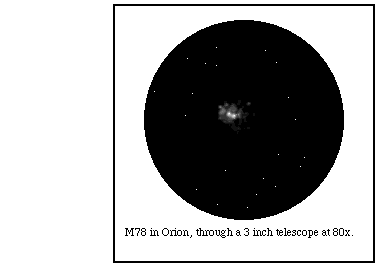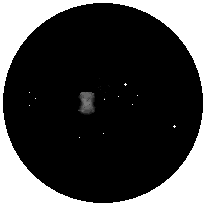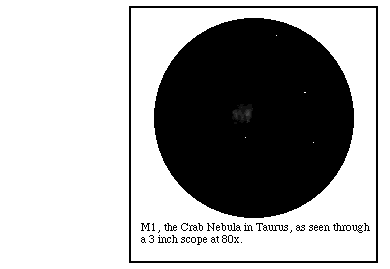| The Orion Nebula, M42, sketched as seen through a 60mm refractor at 79x. The sky was bright with light pollution and moonlight, but plenty of detail was visible. | A negative of the sketch shows some details more clearly, especially star positions. |
Today, "nebula" is used only to describe objects composed mainly of dust and gas. Classes of nebulae are emission nebulae, reflection nebulae, planetary nebulae, supernova remnants, and dark nebulae.
Emission nebulae shine by internally produced light. They are often the birthplaces of stars. M42 in the sword of Orion is the best-known emission nebula and is visible to the naked eye as a cloudy patch. Binoculars and telescopes give very nice views of this wonderful object.
| The Orion Nebula, M42, sketched as seen through a 60mm refractor at 79x. The sky was bright with light pollution and moonlight, but plenty of detail was visible. | A negative of the sketch shows some details more clearly, especially star positions. |
There are not many bright emission nebulae, and these objects are readily wiped out by light pollution. The Lagoon and Trifid nebulae are prominent in the summer sky, although they are not nearly as impressive as M42. The Omega Nebula, M17, is quite impressive in small telescopes. It resembles a swan more than an "omega" to my eyes, and in fact has been nicknamed the Swan Nebula.
Reflection nebulae shine by reflecting light from nearby stars. Most are very faint, but M78 in Orion is visible in any telescope. The Pleiades have quite a bit of reflection nebulosity associated with them, and this is apparent on long exposure photographs.

PLANETARY NEBULAE
Planetary nebulae are layers of gas which have been shed by dying stars. They are often very small and difficult to separate from other stars. The name was given by early telescopic observers, who thought these nebulae looked like washed-out planetary disks. The easiest planetary nebulae to observe are the Ring Nebula (M57) in Lyra and the Dumbbell Nebula (M27) in Vulpecula.
| At 36x in a 60mm refractor,
the Ring Nebula (M57) appears almost starlike. |
At 79x, the nebula is clearly not a star. |
 |
| M27, the Dumbbell Nebula in Vulpecula,
sketched as seen through a 60mm refractor at 36x. |
In these cases, the star which threw off the shell of gas is not visible in a small telescope. NGC 2392, the Eskimo Nebula in Gemini, is smaller than either the Ring or Dumbbell, but its central star is bright enough to be seen in a 2.5 inch telescope at 80x. Planetary nebulae tend to be either very small or very faint; therefore, a large aperture telescope capable of high magnifications is best. Check the database for more interesting targets.
CCD Images of Planetary Nebulae
SUPERNOVA REMNANTS
When a large star dies, the result is a cataclysmic explosion, or supernova. The star is often completely annihilated or leaves behind a small pulsar. The gaseous and plasma remnants slowly diffuse into space, becoming visible as twisted filaments or nebulous blobs. The most famous supernova remnant is the Crab Nebula in Taurus. Another remnant is the Veil Nebula in Cygnus, which is barely visible in a 3" telescope but incredible in a large telescope from a dark site.

Dark nebulae are regions of dust which obscure stars or bright nebulae behind them. During summer, one can look at the Milky way and see a large, dark lane running through the center. This is a complex of dark nebulosity. The Horsehead Nebula in Orion is a famous dark nebula, but is difficult to see in most amateur telescopes.